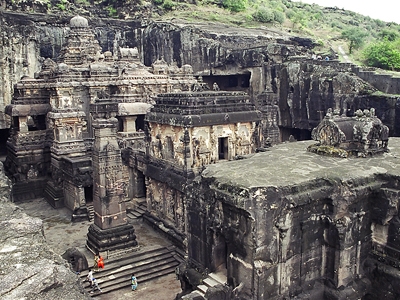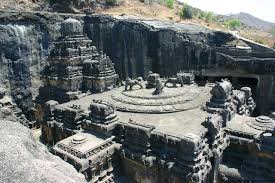Ellora Caves
Ellora caves are in Aurangabad district of Maharashtra. Ellora showcases the experiments that had carried out by Hindu, Buddhist and Jain monks some 600 to 300 years back. It is believed that the structures were carved between 350 AD to 700 AD. There are 34 temples in total carved out of stone at Ellora caves, which can be divided into three eras – Buddhist, Hindu and Jain.
It took over five centuries in scooping out these monasteries, temples and chapels. The Hindu caves are a bit different from the Jain and Buddhist temples in creative vision and execution skills. Cave number 14 is a Shiva temple, depicting Him as a destroyer.
The Kailasnath temple, which is in the 16th cave, is known for its audacious feats in architecture. It is said that nearly 200,000 tonnes of rock had been removed in carving out this temple taking nearly 100 years. Its area is twice the area of the Parthenon in Athens and is 11/2 times higher. Mural paintings are found in 5 caves at Ellora.
There are 34 caves in all: 12 Buddhist caves (500-750 AD), 17 Hindu caves (600-870 AD) and 5 Jain caves (800-1000 AD). The caves are numbered roughly chronologically, starting with the oldest Buddhist caves at the south end.
The Buddhist caves (also called Vishvakarma caves) are the earliest of the Ellora Caves, dating from 500 to 750 AD. All except Cave 10 are viharas (monasteries), which were used for study, meditation, communal rituals, eating and sleeping.
The caves become steadily larger and more elaborately decorated as they progress to the north, which scholars have explained by the growing need to compete with Hinduism for patronage. The earliest Hindu caves at Ellora date from 600 AD, right in the middle of the Buddhist period.
Cave 1 is a plain vihara with eight small monastic cells are very little sculpture. It may have served as a granary for the larger halls.
Cave 2 is much more impressive. A large central chamber supported by 12 great square pillars is lined with sculptures of seated Buddhas. The doorway into the sanctuary is flanked by a muscular Padmapani, holding a lotus, and a bejewelled Maitreya, the Future Buddha. Both are accompanied by their consorts. Inside the shrine is a stately seated Buddha on a lion throne.
Caves 3 and 4 have a similar design as Cave 2, but are in poor condition.
Cave 5 is named the Maharwada Cave because it was used by local Mahar tribespeople as a shelter during the monsoon. It centers on a grand assembly hall stretching 36 meters long, which was probably used as a refectory. The two rows of carved benches support this theory. The shrine Buddha is seated on a stool with his right hand touching the ground in the Earth Witness gesture.
Cave 6 was carved in the 600s and is home to two of the finest sculptures at Ellora. On the left is the goddess Tara, with an intense but kind expression. Opposite her on the right is Mahamayuri, the Buddhist goddess of learning, shown with her attribute, the peacock. A diligent student sits at his desk below. Significantly, Mahamayuri has a very similar Hindu counterpart, Saraswati.
The magnificent Cave 10 dates from the early 700s and is known as the Carpenter’s Cave (Sutar Jhopadi) because of its imitation in stone of wooden beams on the ceiling. At the far end, a seated Buddha is enthroned in front of a large stone stupa.
Cave 11 is known as the Dho Tal or “Two Floors” cave, although a basement level discovered in 1876 brings the total floors to three. The top floor is a long assembly hall lined with columns. It has both a Buddha shrine and images of Durga and Ganesh, indicating the cave was converted into a Hindu temple after it was abandoned by the Buddhists.
Cave 12, known as Tin Tal (“Three Floors”), also has an impressive upper hall. The walls of the shrine room are lined with five large bodhisattvas and is flanked by seven Buddhas, representing each of his previous incarnations.
Created during a time of prosperity and revival of Hindusim, the Hindu caves represent an entirely different style of creative vision and skill than the Buddhist caves. The Hindu temples were carved from top to bottom and required several generations of planning and coordination to take shape.
There are 17 Hindu caves in all (numbered 13 to 29), which were carved between 600 and 870 AD. They occupy the center of the cave complex, grouped around either side of the famous Kailasa Temple.
In contrast to the serene and solemn Buddhas of the earlier caves, the walls of the Hindu caves are covered in lively bas-reliefs depicting events from the Hindu scriptures. All of the caves are dedicated to the god Shiva, but there are also some images of Vishnu and his various incarnations.
Cave 14 dates from the early 600s and was converted from a Buddhist vihara. Its long walls are adorned with magnificently carved friezes and the entrance to the sanctuary is guarded by the river goddess Ganga and Yamuna. Inside, an alcove shelters seven large-breasted fertility goddesses (the Sapta Matrikas) holding chubby babies on their laps. Appearing to their right is the female aspect of Ganesh and the cadaverous goddesses of death, Kala and Kali.
Cave 15 is also a former Buddhist cave adopted by the Hindus. The ground floor is mostly uninteresting, but the top floor has some of the best sculpture at Ellora. Along the right wall are a sequence of panels showing five of Vishnu’s ten incarnations or avatars, which give the cave its name, Das Avatara.
A panel to the right of the antechamber depicts the superiority of Shaivism in the region at the time – Shiva emerges from a linga while his rivals Brahma and Vishnu stand in humility and supplication. The cave’s most elegant sculpture is in the left wall of the chamber: it shows Shiva as Nataraja, the Cosmic Dancer.
The most notable Hindu cave (Cave 16) is not a cave at all, but a magnificent temple carved from the solid rock, patterned closely on the freestanding temples of the time. It represents Mount Kailash, the abode of Lord Shiva, and is called the Kailashnath, Kailash, orKailasa Temple. It originally had a thick coat of white plaster to make it look like a snowy mountain.
The Kailash Temple is a stupendous piece of architecture, with interesting spatial effects and varied sculpture. It is believed to have been started by the Rashtrakuta king Krishna I (756-773). The construction was a feat of human genius – it entailed removal of 250,000 tons of rock, took 100 years to complete and covers an area double the size of Parthenon in Athens.
Many more Hindu caves stretch down the hillside north of Kailash, but only three are must-sees: 21, 25 and 29.
Cave 21, the Ramesvara, dates from the late 500s and is thought to be the oldest Hindu cave at Ellora. It houses some fine sculpture, including a pair of rvier goddesses, two door guardians and some loving couples (mithunas) around the walls of the balcony.
Cave 25 features a sculpture of the sun god Surya driving his chariot towards the dawn.
North of this, the trail soon drops steeply down to a gorge, under a seasonal waterfall, and back up to Cave 29, the Dhumar Lena. Dating from the late 500s, it has an unusual cross-shaped plan. Pairs of lions guard its three staircases. Inside, the walls are covered in large friezes. To the left of the entrance, Shiva slays the Andhaka demon, then defeats the many-armed Ravana’s attempt to shake him and Parvati off the top of Mount Kailash. Don’t miss the dwarf baring his bottom to taunt the demon! On the south side, Shiva teases Parvati by holding her arm back as she prepares to throw dice in a game.
The Jain caves, dating from the late 800s and 900s, are 2 km north down an asphalt road (rickshaws are available). They reflect the distinctiveness of Jain philosophy and tradition, including a strict sense of asceticism combined with elaborate decoration. They are not large compared to others, but contain exceptionally detailed artworks. Many of the Jain caves had rich paintings in the ceilings, fragments of which are still visible.
The most notable of the group is Cave 32, the Indra Sabha (Indra’s Assembly Hall), a miniature of the Kailash Temple. The bottom level is plain but the upper floor has elaborate carvings, including a fine lotus flower on the ceiling. Two tirthankaras guard the entrance to the central shrine. On the right is the naked Gomatesvara, who is meditating deeply in the forest – so much so that vines have grown up his legs and animals, snakes and scorpions crawl around his feet.
Maharashtra government organizes Ellora Festival of Classical Dance and Music every year at these caves. Aurangabad is well connected by air, rail and road.


